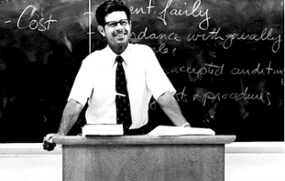
Alan R. Cerf
Professor of Accounting, Emeritus
Alan Robert Cerf had just come home from a swim when his heart failed on August 24, 2017. He was 93 years old. Alan was born on March 26, 1924 in San Francisco to Arthur and Addie Zander Cerf. He graduated from George Washington High School in 1941 and from the University of California, Berkeley, in 1944. He attended Harvard Business School for one year as part of the V-12 Navy College Training Program before shipping out to Okinawa as paymaster. He returned to Harvard after the war and graduated with an M.B.A. in 1947. Alan started teaching at Berkeley in 1955 as an acting assistant professor just prior to completing a Ph.D. in economics at Stanford University in 1956.
During the 1940s, Berkeley’s College of Commerce became the School of Business (and later, the Haas School of Business), with accounting one of its strengths. The young faculty members of the time introduced new programs and technologies into their courses. Over the course of his career, Alan saw many changes in the field of accounting, including the exponential growth of knowledge and information. He also saw a change in emphasis from studying specialized areas to a broader managerial approach to teaching about all aspects of business. Alan was chair of the accounting group from 1978 to 1982 and he was the first director of the Evening M.B.A. program when its courses were being held in San Francisco.
Alan’s research was in three areas of accounting; financial accounting, taxation, and real estate investment. His early work was mostly in financial reporting where he examined classical accounting questions such as price level changes and inventory valuation. His book, Corporate Reporting and Investment Decisions (1961) reflects this work. Here Alan pioneered in developing a disclosure form for individual firms based on the company’s annual reports. He then examined how factors such as firm size, U.S. Security and Exchange Commission (SEC) requirements, and frequency of external financing affect company disclosure policy. This book is one of the first to systematically examine company disclosure behavior, an area that was subsequently studied extensively.
Alan’s later work focused on tax and real estate investment. For example, he studied how the 1986 Tax Reform Act affects charitable contributions. In particular, he examined the operation of the Alternative Minimum Tax (AMT) and how it must be considered in gifts of appreciated long-term capital gain property.
In 1984 Alan received the Faculty Excellence Award for Education and Research from the California Certified Public Accountants Foundation. In 2011, the Haas School awarded him the Lifetime Achievement Award for Distinguished Contributions to the accounting program at Berkeley. “I figured out the other day that I’ve taught 13,440 students,” he told the Haas community. As noted when he won the Lifetime Achievement Award, he had witnessed the growth in the number of female students from a conspicuous few, to a majority in his classes. Of all the things Alan did, he said that the most enjoyable was teaching.
In 2014 he was the longest-serving tenured professor on the Berkeley campus. He was still teaching until shortly before his death. Student reflections illustrate their appreciation of him. “Taxation is very difficult and he didn’t make it easy, but he emphasized things I’m still learning . . . If you’d done the reading for the class and were ready to ask questions you’d get a lot from him.” “He’s an awesome professor!! He has been teaching at Cal for forty years. Tax isn’t as boring as I thought it was, all because of him.” “A good guy and a legend, he’s been teaching at Cal forever. He calls on people so you gotta be aware all the time, but he’ll help you if you don’t know the answer.”
Alan’s wife, Lila Spitzer Cerf, was “the love of his life.” They were married for 65 years. They had four sons, Robert, Douglas, Richard, and Jeffery, and one daughter, Nancy, 11 grandchildren, and three great-grandchildren. His family said they could see the love in his eyes and hugs. They also noted that Alan embodied what it meant to be a teacher, friend, compassionate father and grandfather, and a loving husband.
Karlene Roberts
Xiao-Jun Zhang
2018
